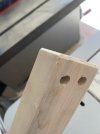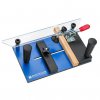Hey again folks. I am finally working on a piece of furniture (vs. cabinets and shop stuff) and I am learning a lot about angles, dowel joinery, etc... I wanted to ask about any methods to avoid tear out when chamfering the legs of a small desk. I’ve always heard to chamfer the feet to avoid chipping but I had some pretty bad tear out on the end grain. I’m only working with premium pine so maybe that’s the reason? I tried my router table with a good sharp bit and a little block plane. Advice?
You are using an out of date browser. It may not display this or other websites correctly.
You should upgrade or use an alternative browser.
You should upgrade or use an alternative browser.
End grain chamfer tear out
- Thread starter nick roberts
- Start date
Pine can be a bugger - need very sharp tools and sometimes even that ain’t enough. I always get tear out on the router table with dovetails and anything that isn’t with the grain. Need backer boards whenever you can. Frustrating to say the least.
Also make sure you cut the end grain first. That way some tear out is hidden when the long grain is chamferred. Backer boards are the biggest help though as it supports the grain that is prone to tear out.
As others have stated, the wood fibers need to be supported to avoid tear out (backer board). The same principle as a zero clearance insert (ZCI) on the tablesaw.
Of course! Backer boards - I use them in so many other applications. I guess I just needed to think about “how” with such a small cut. I suppose a miter fence with sacrificial fence could happen. Thanks again folks
I’ve heard that but it hurt my brain a little bit because the chamfer was “all end grain”?? (End of the leg that is)Also make sure you cut the end grain first. That way some tear out is hidden when the long grain is chamferred. Backer boards are the biggest help though as it supports the grain that is prone to tear out.
Backer board and cut end grain 1st, both excellent advice. Put a fresh face on the backer board for each cut. When you cut the bottom of the legs on the end grain, make your 1st cut, then rotate the leg so that the next cut finishes on the 1st cut face, then progress through all faces in this pattern. Having part of the wood already cut out eliminates a lot of tear out.
He may have meant "edge grain." Imagine that the narrow sides (edges) are 12 & 6, and the wide sides (faces) are 3 & 9. To reduce the likelihood of spelching, you want to cut your chamfer in this order: 12-3-6-9.I’ve heard that but it hurt my brain a little bit because the chamfer was “all end grain”?? (End of the leg that is)
No backer board needed. A SHARP chisel or block plane. If you work in the direction toward of the bottom of the leg rather than across the grain, this way you're always going with the grain.
If not, you are always cutting across the grain, which is more challenging in soft wood.
If not, you are always cutting across the grain, which is more challenging in soft wood.
Also do cross grain FIRST then with the grain, usually cleans everything up
Roy Underhill showed that specifically with a plane a few days ago on his show. Cross grain and then with the grain to remove any tear out.
LATEST FOR SALE LISTINGS
-
Graco 395 FinishPro air assisted airless sprayer for sale
- Started by RobH
- Replies: 1
-
-
-
-


